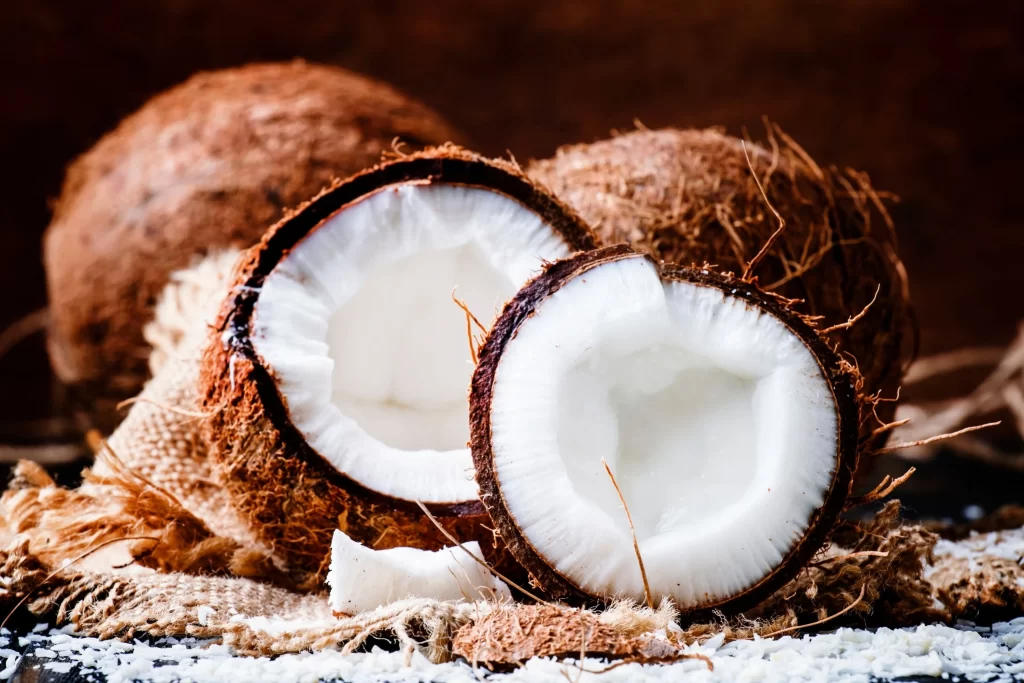Classifying coconuts is a notoriously difficult task. They have a hard outer shell that needs to be split open, just like nuts, yet they are quite sweet and may be eaten like fruits. So this brings us to the question: is coconut a fruit?

Despite the term “nut” appearing in its name, a coconut is a fruit. Coconut belongs to a subclass of fruits called drupes, which are described as having a hard shell around the seed and inner meat. This covers a wide range of fruits, including almonds, walnuts, pears, and peaches.
This article clarifies if a coconut counts as a fruit or not.
What is a Coconut?
The tropical fruit coconut is well-known for its delicious white flesh encased in a tough, brown shell, which separates from the liquid known as coconut water. People frequently use its meat and derive coconut oil for cooking.
Many dishes, drinks, and desserts incorporate coconut water, utilising it in a variety of culinary applications.
READ ALSO:
How to Open a Coconut
Just like the saying “There are many ways to bell a cat,” there are several ways to open a coconut.
Method one:
Use a skewer to poke the coconut’s “eyes” to determine which one is soft. Push the skewer through the soft eye to make a 1/2-inch hole when it starts to function.
Shake the coconut over a bowl to release the liquid and drain the water.
After breaking the coconut’s shell in half, place the cut side down on a level surface and tap with a mallet to free the flesh.
Gently extract the remaining meat using a butter knife. After removing the brown skin from the flesh with a vegetable peeler, wash the parts.
Method Two:
Preheat the oven to 400 °F (204 °C), then bake the coconut for 15 to 20 minutes.
Examine the coconut for cracks after 15 minutes. Continue baking the coconut for a further five minutes, or until fault lines start to appear if no cracks have occurred.
After heating the coconut, you’ll still need to use force to open it—by smashing or hitting it against anything hard.
After taking out the coconut, cover it with a towel to chill. By doing this, you can be sure that when you break the coconut in the following step, heated pieces won’t fly everywhere.
Use a hammer to strike the coconut against a hard surface. Use a concrete surface, and refrain from hitting it on your countertop!
Taking each broken piece of coconut, slide a knife between the white meat and the shell to separate them. To get rid of the fibrous coating that sticks to the coconut meat, you can alternatively use a vegetable peeler.
How to Toast Coconut
A fantastic texture and depth of taste may be added to many meals by using toasted coconut. You may add toasted coconut to cookie dough, cake batter, pudding batter, or as a garnish for layer cakes, pies, and puddings. It’s also the perfect garnish for a yoghurt parfait or smoothie bowl.
Here are several methods for toasting coconut:
In the oven:
When toasting coconut in large quantities, this method works well and produces uniform browning. Set an elongated baking sheet with parchment paper on the edge, and top it with a layer of shredded coconut. Preheat the oven to 325°F.
In the oven, toast the coconut for 8 to 10 minutes, stirring every 3 to 4 minutes, or until it turns brown. Remove the baking sheet from the oven and allow the toasted coconut to cool completely before use.
On the stove:
This approach necessitates almost continuous focus. Fill a medium skillet with one to two cups of shredded coconut. Reduce the heat to medium and stir often. The coconut will turn light brown in five to seven minutes.
In the microwave:
Arrange the coconut shreds evenly in a dish that is suitable to use in the microwave. The coconut should be microwaved for 30 seconds at a time, stirring in between. It will take the coconut four to five minutes to start browning. Smaller amounts will require less time.
READ ALSO:
What are the Benefits of Coconut?
Coconut is a great low-carb alternative to snacks that are high in carbohydrates. Iron, copper, manganese, potassium, sodium, vitamin B, and manganese are among the nutrients and minerals it contains. Manganese is good for the health of our bones. Iron and copper support the health of red blood cells.
Medium-chain triglycerides, which are abundant in coconut flesh, give users immediate energy and help obese people lose weight. High amounts of heart-healthy (HDL) cholesterol can be found in coconut flesh and oil.
Because coconut is low in carbohydrates and high in fibre, it helps regulate our blood sugar levels. Numerous antioxidants included in coconut meat and water guard against agents that damage cells. Additionally, the antioxidants lower the incidence of many diseases, such as cancer.
Conclusion
Perceiving coconut as generally healthy, individuals may experience negative effects like allergies, high cholesterol, and potential overdosing with excessive consumption, depending on the consumer’s age.
Coconuts have several health advantages: they are high in heart-healthy fats, may improve digestion, and may strengthen the immune system due to their antioxidant content. Furthermore, coconut may possess antibacterial and anti-inflammatory qualities.
